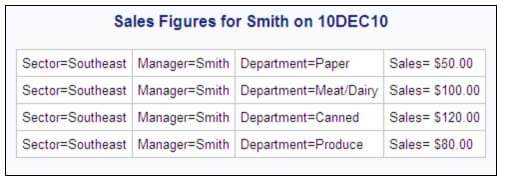REPORT Procedure
- Syntax

- Overview
- Concepts
- Using
- Results
- Examples
 Selecting Variables for a ReportOrdering the Rows in a ReportUsing Aliases to Obtain Multiple Statistics for the Same VariableConsolidating Multiple Observations into One Row of a ReportCreating a Column for Each Value of a VariableDisplaying Multiple Statistics for One VariableStoring and Reusing a Report DefinitionCondensing a Report into Multiple PanelsWriting a Customized Summary on Each PageCalculating PercentagesHow PROC REPORT Handles Missing ValuesCreating and Processing an Output Data SetStoring Computed Variables as Part of a Data SetUsing a Format to Create GroupsSpecifying Style Elements for ODS Output in the PROC REPORT StatementSpecifying Style Elements for ODS Output in Multiple StatementsUsing Multilabel FormatsUsing the WIDTH= and CELLWIDTH= Style Attributes with PROC REPORT
Selecting Variables for a ReportOrdering the Rows in a ReportUsing Aliases to Obtain Multiple Statistics for the Same VariableConsolidating Multiple Observations into One Row of a ReportCreating a Column for Each Value of a VariableDisplaying Multiple Statistics for One VariableStoring and Reusing a Report DefinitionCondensing a Report into Multiple PanelsWriting a Customized Summary on Each PageCalculating PercentagesHow PROC REPORT Handles Missing ValuesCreating and Processing an Output Data SetStoring Computed Variables as Part of a Data SetUsing a Format to Create GroupsSpecifying Style Elements for ODS Output in the PROC REPORT StatementSpecifying Style Elements for ODS Output in Multiple StatementsUsing Multilabel FormatsUsing the WIDTH= and CELLWIDTH= Style Attributes with PROC REPORT
Example 7: Storing and Reusing a Report Definition
| Features: |
|
| Other features: |
TITLE statement WHERE statement |
| Data set: | GROCERY |
| Formats: | $MGRFMT |
Details
The first PROC REPORT
step in this example creates a report that displays one value from
each column of the report, using two rows to do so, before displaying
another value from the first column. (By default, PROC REPORT displays
values for only as many columns as it can fit on one page. It fills
a page with values for these columns before starting to display values
for the remaining columns on the next page.)
Program to Store a Report Definition
libname proclib
'SAS-library';
options fmtsearch=(proclib);
proc report data=grocery nowd
named
wrap
ls=64 ps=36
outrept=proclib.reports.namewrap;
column sector manager department sales;
define sector / format=$sctrfmt.; define manager / format=$mgrfmt.; define department / format=$deptfmt.; define sales / format=dollar11.2;
where manager='1';
title "Sales Figures for Smith on &sysdate"; run;
Program Description
Specify the format search library.The SAS system option FMTSEARCH= adds the SAS library
PROCLIB to the search path that is used to locate formats.
Specify the report options. The
NOWD option runs PROC REPORT without the REPORT window and sends its
output to the open output destinations. NAMED writes name= in
front of each value in the report, where name= is
the column heading for the value. When you use NAMED, PROC REPORT
suppresses the display of column headings at the top of each page.
Specify the report columns. The
report contains a column for Sector, Manager, Department, and Sales.
Define the display and analysis variables. Because no usage is specified in the
DEFINE statements, PROC REPORT uses the defaults.
The character variables (Sector, Manager, and Department) are display
variables. Sales is an analysis variable that is used to calculate
the sum statistic. FORMAT= specifies the formats to use in the report.
define sector / format=$sctrfmt.; define manager / format=$mgrfmt.; define department / format=$deptfmt.; define sales / format=dollar11.2;
Select the observations to process. A report definition might differ from the SAS program
that creates the report. In particular, PROC REPORT stores neither
WHERE statements nor TITLE statements.
Output
Program to Use a Report Definition
options fmtsearch=(proclib);
proc report data=grocery report=proclib.reports.namewrap
nowd;
where sector='sw';
title "Sales Figures for the Southwest Sector on &sysdate";
run;
Program Description
Specify the format search library.The SAS system option FMTSEARCH= adds the SAS library
PROCLIB to the search path that is used to locate formats.

